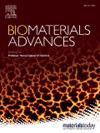Thin-film NiTi intrasaccular implant with flaps for aneurysm treatments
IF 6
2区 医学
Q2 MATERIALS SCIENCE, BIOMATERIALS
Materials Science & Engineering C-Materials for Biological Applications
Pub Date : 2025-04-11
DOI:10.1016/j.bioadv.2025.214311
引用次数: 0
Abstract
Intracranial aneurysms are abnormal, balloon-like formations in the brain blood vessels. They carry a high risk of rupture, which can cause severe complications. Effective aneurysm treatments include reducing blood flow into the aneurysm sac. Coiling is an effective method of occluding the aneurysm sac. However, wide-neck aneurysms are associated with complications because large necks make it difficult to retain the coils securely in the aneurysm sac. This challenge can be overcome by using coil-assisting implants. This additional support avoids the risk of coils migrating into the parent artery avoiding such complications such as ischemic stroke.
This study introduces a novel, coil-assisted implant design with flaps fabricated using micro-electromechanical system (MEMS) technology, which provides a higher degree of freedom in designing and prototyping. The designs contain a stable mechanical backbone with mobile thin flaps that allow secondary delivery of coils into the aneurysm sac. Mechanical tests are conducted to measure radial forces for secure anchoring in the aneurysm sac and compression forces to assess the hammering effect from pulsatile blood flow. Furthermore, the novel implants were tested and compared with a commercial braided implant in in-vitro environment using 3D-printed aneurysm models to understand their flow dynamics and coiling performance by using digital subtraction angiography. The findings showed that backbone/flap designs have greater mechanical stability, which enhances effectiveness compared to braided coil-assisting implants. Moreover, coiling was possible through mobile flaps, highlighting the potential for advancing the treatment of brain aneurysms.

带皮瓣的镍钛囊内薄膜植入物用于动脉瘤治疗
颅内动脉瘤是在脑血管中形成的异常的球状结构。它们破裂的风险很高,可能导致严重的并发症。有效的动脉瘤治疗包括减少动脉瘤囊内的血流量。卷取是一种有效的动脉瘤囊闭塞方法。然而,宽颈动脉瘤与并发症有关,因为大的颈部很难将线圈安全地保留在动脉瘤囊中。这一挑战可以通过使用线圈辅助植入物来克服。这种额外的支持避免了线圈迁移到母动脉的风险,避免了缺血性中风等并发症。本研究介绍了一种新颖的,利用微机电系统(MEMS)技术制造的线圈辅助植入物设计,该设计在设计和原型制作方面提供了更高的自由度。该设计包含一个稳定的机械骨干,带有可移动的薄皮瓣,允许将线圈二次输送到动脉瘤囊中。进行力学试验以测量在动脉瘤囊内安全锚定的径向力和评估脉动血流锤击效应的压缩力。此外,使用3d打印动脉瘤模型对新型植入物进行了测试,并与商业编织植入物在体外环境中进行了比较,通过数字减影血管造影了解其流动动力学和卷曲性能。研究结果表明,与编织线圈辅助植入物相比,骨干/皮瓣设计具有更高的机械稳定性,从而提高了有效性。此外,通过移动皮瓣可以卷绕,突出了推进脑动脉瘤治疗的潜力。
本文章由计算机程序翻译,如有差异,请以英文原文为准。
求助全文
约1分钟内获得全文
求助全文
来源期刊
CiteScore
17.80
自引率
0.00%
发文量
501
审稿时长
27 days
期刊介绍:
Biomaterials Advances, previously known as Materials Science and Engineering: C-Materials for Biological Applications (P-ISSN: 0928-4931, E-ISSN: 1873-0191). Includes topics at the interface of the biomedical sciences and materials engineering. These topics include:
• Bioinspired and biomimetic materials for medical applications
• Materials of biological origin for medical applications
• Materials for "active" medical applications
• Self-assembling and self-healing materials for medical applications
• "Smart" (i.e., stimulus-response) materials for medical applications
• Ceramic, metallic, polymeric, and composite materials for medical applications
• Materials for in vivo sensing
• Materials for in vivo imaging
• Materials for delivery of pharmacologic agents and vaccines
• Novel approaches for characterizing and modeling materials for medical applications
Manuscripts on biological topics without a materials science component, or manuscripts on materials science without biological applications, will not be considered for publication in Materials Science and Engineering C. New submissions are first assessed for language, scope and originality (plagiarism check) and can be desk rejected before review if they need English language improvements, are out of scope or present excessive duplication with published sources.
Biomaterials Advances sits within Elsevier''s biomaterials science portfolio alongside Biomaterials, Materials Today Bio and Biomaterials and Biosystems. As part of the broader Materials Today family, Biomaterials Advances offers authors rigorous peer review, rapid decisions, and high visibility. We look forward to receiving your submissions!

 求助内容:
求助内容: 应助结果提醒方式:
应助结果提醒方式:


